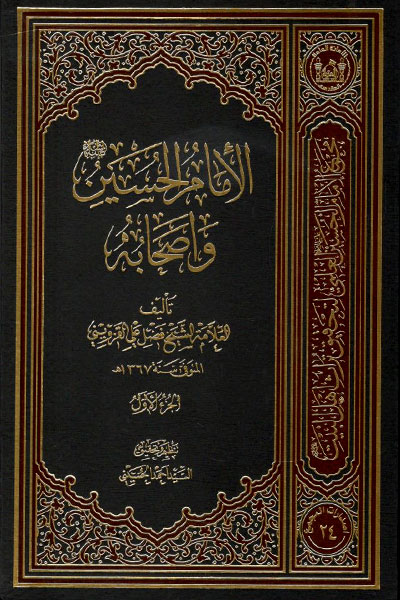The Ashura Battle of Karbala has left its historic impact on the whole Islamic history. Right from the beginning of the movement initiated by Imam al-Ḥusayn up to the present hundreds of books and treatises have been written on this incident, and there does not seem to be any end to it, all due to its significance, attraction, and impact. One of such books is the volume under review. The author Sheikh Faḍl-ʽAlī al-Qazwīnī was born at the village of Tanureh, a suburb of Alamut in the vicinity of Qazwin, Iran, in 1290 AH/ 1873. After receiving some primary education at his village, he went to Qazwin at the age of 15 for further education. After Qazwin, he migrated to Tehran. Having studied for several years, he went to Isfahan that had nationwide reputation for Shii Islamic religious education. In Isfahan, he studied logic and philosophy, too. Another phase of his religious education took shape when he left Isfahan for Najaf where he resided for around two years or so. He proved a hardworking disciple of the leading ulemas of Najaf so that he obtained the ijtihad license from them.
Already well-versed in Shii Islamic religious education in Najaf, he returned back to Qazwin at the suggestion of his teacher Grand Ayatollah Muḥammad Kāẓim Khurāsānī in around 1327 AH/ 1909.
 Although his main seat was Qazwin, he used to travel to Mashhad and Qum on pilgrimage every year. Even in the pilgrimage cities, he delivered his lessons to a number of scholars who were interested in his character and academic career. He remained in Qawin until it was when Reza Khan Pahlavi (d. 1944) committed the horrible massacre at the Gowharshād Congregational Mosque, adjacent to Imam al-Riḍā’s Holy Shrine in Mashhad. As he found the situation too critical to remain in Qazwin, for Reza Khan exerted too much pressure on Shii clerics who opposed his policies and conduct. In consequence of such pressure, he migrated to Karbala and remained there for 14 months. There he continued his academic life and authored several books, among them the book under review here. From there he decided to go on pilgrimage to Imam al-Riḍā’s Holy Shrine in Mashhad. On the way to Mashhad, he became sick at Qum and passed away there in 3rd Shaban 1367 AH/ 1947. He was buried at Sheykhaan Cemetery to the east of Fāṭimah al-Maʽṣūmah’s holy shrine.
Although his main seat was Qazwin, he used to travel to Mashhad and Qum on pilgrimage every year. Even in the pilgrimage cities, he delivered his lessons to a number of scholars who were interested in his character and academic career. He remained in Qawin until it was when Reza Khan Pahlavi (d. 1944) committed the horrible massacre at the Gowharshād Congregational Mosque, adjacent to Imam al-Riḍā’s Holy Shrine in Mashhad. As he found the situation too critical to remain in Qazwin, for Reza Khan exerted too much pressure on Shii clerics who opposed his policies and conduct. In consequence of such pressure, he migrated to Karbala and remained there for 14 months. There he continued his academic life and authored several books, among them the book under review here. From there he decided to go on pilgrimage to Imam al-Riḍā’s Holy Shrine in Mashhad. On the way to Mashhad, he became sick at Qum and passed away there in 3rd Shaban 1367 AH/ 1947. He was buried at Sheykhaan Cemetery to the east of Fāṭimah al-Maʽṣūmah’s holy shrine.
The book under review consists of three main sections as devised by the author, while the printed edition has a fourth volume which is devoted to user-friendly indexes. The first volume, in 473 pages, deals with Imam al-Ḥusayn’s excursion from the moment he decided to leave Medina for Mecca and from there to Iraq. The book takes the reader step by step with Imam al-Ḥusayn and station by station listens to the addresses and talks of Imam al-Ḥusayn with his associates. The first volume of the book finishes with the martyrdom of Imam al-Ḥusayn.
The second volume is devoted to the martyred companions of Imam al-Ḥusayn. As both the precise number of the martyred companions and the correct pronunciation of their names are at times baffling, the book solves this problem in a scholarly way. The book lists 168 martyrs, not 72 that is oft-quoted number. In addition to their brief biographies and battlefield poems (rajazes), the book also records their conversations with Imam al-Ḥusayn. The book answers some queries, too, for example about who was the first martyr of the Hāshimids, or what was the age of Imam al-Ḥusayn’s elder son, ʽAlī al-Akbar.
The third volume of the book deals with the survivors of the Ashura Battle of Karbala. In this volume, female survivors are listed. After that there are two sections devoted to two ladies, both called Zaynab, who were present at Karbala. Their brief biographies and talks are recorded, too.
As for the males who outlived the horrible Karbala massacre, first a list of 12 men are mentioned. Two of them are the 4th Infallible Imam ʽAlī b. al-Ḥusayn “al-Sajjād” and his son, the fifth Infallible Imam Muḥammad “al-Bāqir”. The last section of the book deals with what happened to Imam al-Sajjād, and the return of the Ashura captives back to Medina.
The fourth volume of the book contains only various indexes. They deal with the Quranic verses mentioned, personal and place names, names of the Arab tribes involved, and important keywords used throughout the text.
Muhammad-Reza Fakhr-Rohani
University of Qum,
Iran.
